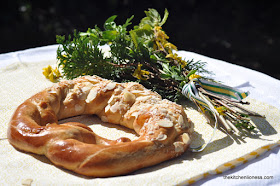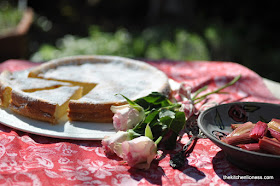Palm Sunday (
Palmsonntag) otherwise known as
Passion Sunday, is
April 5 this year, marking the first day of
Holy Week (
Karwoche), the last week of
Lent (
Fastenzeit) which starts on Palm Sunday and ends on
Easter Sunday (
Ostersonntag). It commemorates the biblical account of Jesus’ triumphant and last ride into Jerusalem on a donkey as the faithful spread palm branches in his path to welcome him.
‚Crowds of people welcomed Jesus to Jerusalem, throwing their cloaks in his path and waving palm branches‘ (John 12:19, Mark 11:1-11, Matthew 21:1-11).
There are
many traditions that take place on Palm Sunday but one of the most popular that actually dates back to the 8th century is the
Palm Sunday processions (
Palmsonntag Prozessionen) through the streets, traditionally held before church service. Some German parishes and towns still hold these palm parades. After church services, the blessed '
palm twig bouquets' (
Palmwedel), many decorated with colorful ribbons, are taken home and while many Christians keep them in their homes all year as a symbol of their faith and place them in vases, others burn them and save the ashes to use on A
sh Wednesday (
Aschermittwoch) of the following year. According to old beliefs, the palm bouquets may ward off evil and may even protect the home from lightning and stormy weather.
Since palms don’t usually grow in central and northern Europe, instead of palm fronds, various locally available greenery such as box, yew, birch, hazelnut, forsythia or willow twigs and branches are substituted and brought to church.
In certain areas of southwest Germany, peasant customs from the past are preserved as in olden times and some farmers still mix dried pussy-willows into their animal feed to protect them against sickness and epidemics.
The very popular
Pretzel (
Brezel) is a type of baked pastry made from dough that is commonly shaped into a knot. The traditional pretzel shape is a distinctive symmetrical form, with the ends of a long strip of dough intertwined and then twisted back onto itself in a particular way (a pretzel loop). In modern times, pretzels come in a wide range of shapes, size and flavors.
Salt is the most common seasoning for pretzels, complementing the soda or lye treatment that gives pretzels their traditional skin and flavor acquired through the Maillard reaction. Varieties of pretzels include soft pretzels, which should be eaten shortly after preparation, and hard-baked pretzels, which have a long shelf life.
The German name '
Brezel'
is said to
derive also from the Latin word 'bracellus' (a medieval term for 'bracelet') or 'bracchiola' (meaning 'little arms'). Popular stories claim that the pretzel was invented by a baker
to represent Christian monks crossing their arms in prayer.
The pretzel has also been in use as an
emblem of bakers and formerly their guilds in southern German areas since at least the 12th century.
Within the
Christian Church, pretzels were regarded as having
religious significance for both ingredients and shape. Pretzels called
Lenten Prezels (
Fastenbrezel) are traditionally made with a simple recipe using only flour and water and could be eaten during
Lent (
Fastenzeit) when Christians were forbidden to eat eggs, lard, or dairy products such as milk and butter. Their texture and flavor resembles rusks (Zwieback). As time passed, pretzels became associated with
both Lent and Easter.
Especially in Catholic areas, such as Austria, Bavaria, or some parts of Swabia, the
Palm Pretzel (Palmbrezel) is made only for Palm Sunday celebrations. Their size and weight can vary considerably but Palm Pretzels are larger than usual and are made without salt or brine. They are meant
as Lenten fare only for Palm Sunday. In some Catholic areas, these pretzels are part of the decorated '
palm sticks' (
Palmstecken), they are mounted on colorful decorated poles, carried through the streets to church to be blessed there and later shared with family and friends.
Palm Pretzels
(the recipe yields 6)
Ingredients
- 1000g strong baking flower (around here ‚Type 550‘)
- 140g superfine baking sugar
- 100g unsalted butter
- 30g lard (you can substitute an equal amount of butter)
- 10g fine salt
- 42g fresh yeast OR use 21g active dry yeast or 14g instant yeast instead
- 2 eggs (L), free-range or organic
- 400 bis 450 ml lukewarm milk (I like to use full fat milk)
- Grated zest from an organic/untreated lemon (you can substitute orange zest or use vanilla sugar instead
In Addition
- 1 egg (L), free-range or organic
- some milk
- flaked almonds and coarse sugar
Preparation
- Add all the ingredients to the bowl of your stander mix and knead for about 7 to 10 minutes.
- Cover the dough and let rise in a draft-free/warm spot for about an hour or until doubeld in volume.
- Place the risen dough on your lighty-floured work surface.
- Using a bench scraper, divide the dough into six equals parts (each part will weigh about 300g), then divide each portion into 3 equal portions each (that will equal 18 portions weighing about 100g each).
- Taking one portion at a time, roll the dough into a long strand - use the palms of your hands to roll it back and forth against the counter top. Push the dough outwards as you roll until you achieve the desired length of about 35 cm.
- Then take 3 strands and braid the middle part only, squeeze the ends together and roll them together.
- Then pick up the two ends and twist them around each other. Attach the twisted section to the left and the right of pretzel and pinch them firmly into the dough. Repeat with the remaining dough. When you are done, you should have 6 pretzels.
- Place two on one parchment lined baking sheet, brush with some egg and milk mixed together, cover loosely and let rise again for about 20 to 30 minutes.
- In the meantime pre-heat your oven to about 180°C (356°F).
- After the second rise, brush again with egg mixture, sprinkle some coarse sugar and flaked almonds on the middle parts (optional) and bake in the pre-heated oven for about 20 to 25 minutes or until golden.

Palmbrezeln
(für ca. 6 Palmbrezeln)
Zutaten
- 1000g Weizenmehl 'Type 550' (kann auch durch 500g 'Type 405' und 500g Type 550' ersetzt werden)
- 140g feinster Backzucker
- 100g Butter
- 30g Schweineschmalz (kann auch durch Butter ersetzt werden)
- 10g feines Salz
- 42g frische Hefe (oder 14g Trockenhefe, also 2 Packungen)
- 2 Eier (L), Bio-oder Freilandhaltung
- 400 bis 450ml lauwarme Milch
- abgeriebene Schale einer Bio-Zitrone (kann auch durch Bio-Orange oder Vanillemark oder -pulver ersetzt werden)
Zusätzlich
- 1 Ei (L), Bio-oder Freilandhaltung
- etwas Milch
- Mandelblättchen und etwas Hagelzucker
Zubereitung
- Alle Zutaten 7 bis 10 Minuten in der Teigknetmaschine zu einem Hefeteig verkneten.
- Den Teig zugedeckt an einem warmen Ort zirka 1 Stunde ruhen lassen bis er gut aufgegangen ist bzw, bis es sich verdoppelt hat.
- Aus der Schüssel nehmen und auf die leicht bemehlte Arbeitsfläche geben.
- Anschließend sechs Portionen mit je zirka 300g abstechen und jede Portion nochmal in 3 gleich große Stücke teilen (ergibt 18 gleich große Stücke à zirka 100g).
- Alle Stücke zu Strängen vorrollen. Dann jeden Strang zu einer Länge von zirka 35cm lang ausrollen, dabei darauf achten, dass alle Stränge gleich stark sind.
- Dann jeweils 3 Stränge in der Mitte zu einem 3-Strang-Zopf flechten, die Enden gut zusammendrücken und dann zusammen ausrollen.
- Die Enden über Kreuz legen, dann einmal verdrehen und links und rechts das Ende festdrücken.
- Jeweils zwei Palmbrezelteiglinge auf ein Backblech legen, mit Eistreiche (Ei mit Milch) bepinseln, zudecken und nochmals zirka 20 bis 30 Minuten aufgehen lassen.
- In der Zwischenzeit den Ofen vorheizen (180°C).
- Dann nochmals mit Eistreiche einpinseln, mit Mandelblättchen und Hagelzucker verzieren und im vorgeheizten Ofen zirka 20 bis 25 Minuten backen oder bis die Brezel goldbraun sind.

Please note that this blog post is part of my series for a 'local' radio station, where, throughout the years, I present different baked goods that are closely tied to various holidays and seasons. If you are interested, have a LOOK & LISTEN (in German)HERE.
The various recipes of my series can be found here:
- in January, for Three Kings Day (Dreikönigstag) two kinds of Galette des Rois (Dreikönigskuchen) (HERE)
- for Lent (Fastenzeit) Lenten Soup with Lenten Beugel (Fastenbeugel) (HERE)
- for Good Friday (Karfreitag) the delicious Hot Cross Buns (HERE)
- for Pentecost /Whitsun (Pfingsten) the fun Allgäu Bread Birds (Allgäuer Brotvögel) (HERE)
- for the beginning of the summer vacation, the lovely Sacristains (Almond & Sugar Puff Pastry Sticks) (HERE)
- for St Christopher's Day (St Christophorus), the energy-packed Müsli Power Bars (Müsli Energieriegel) (HERE)
- for Mary's Assumption Day (Mariä Himmelfahrt) my Tear & Share Herb Bread (Kräuterbrot) (HERE)
- for Mary’s Birthday (Mariä Geburt) some very pretty Mary’s Sweet Rolls (Süße Marienküchlein) (HERE)
- for Thanksgiving (Erntedankfest) a delicious and seasonal Thanksgiving Apple Tart with Frangipane (Erntedank Apfeltarte mit Mandelcreme) (HERE)
- for Halloween a Pumpkin Spice Bundt Cake (Kürbis-Gewürzkuchen)
- for St Martin's Day (Martinsfest) the cheerful Sweet Dough Men (Weckmänner) (HERE)
- for St Andrew's Day (Andreastag) a classic Petticoat Tails Shortbread (HERE)
- for Christmas Day (Weihnachten) these Traditional German Gingerbread (Elisenlebkuchen) (HERE)
- for New Year's Eve a New Year's Eve Pretzel (Neujahrsbretzel)
- for Candelmas Day (Mariä Lichtmess) some delightful Navettes de Saint Victor (HERE)
- for Carnival Season (Karneval) these lovely Carnival Doughnuts (Karnevals-Krapfen) (HERE)
- for St Patrick's Day a traditional Irish Brown Soda Bread (Irisches Sodabrot)(HERE)
- for St Joseph's Day a long-forgotten but thankfully re-discovered Sweet Cotton Bread (Baumwollbrot)(HERE)
- for Palm Sunday (Palmsonntag) these very pretty Palm Pretzels (Palmbrezel) (HERE)
- for Easter Sunday (Ostersonntag) an Easter Brunch at Home with Tarte Flambée (Flammkuchen) (HERE)
- for the Month of May (Marienmonat Mai) these elegant Visitandines de Nancy (HERE)
- for Pentecost/Whitsun these festive Beignets (Heiliggeistkrapfen) (HERE) - more delicious treats to come very soon.




































